
There are other telephone poles to put leaflets on….
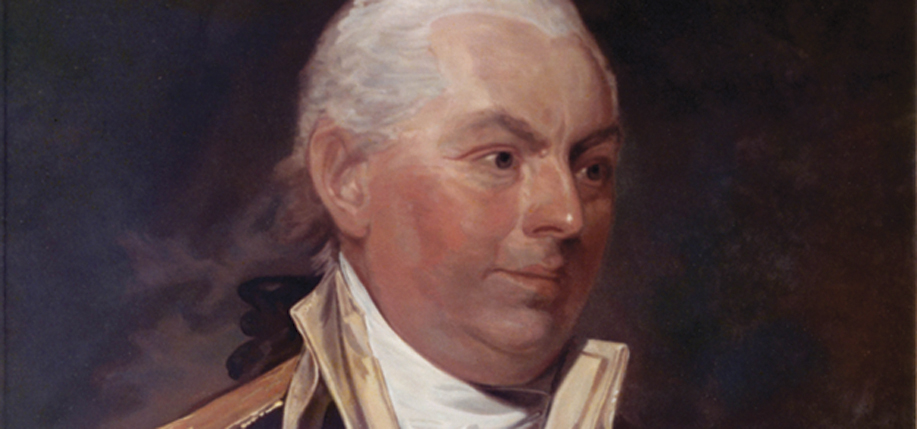
John Barry, by Gilbert Stuart
By Edythe Preet, Columnist
April / May 2016
Irish nationals were instrumental in helping secure American independence from England during the Revolutionary War. Edythe Preet explores the key figures.
℘℘℘
John Barry
County Wexford
Driven from their ancestral home by the British, the Barry family relocated to the American colonies, where John Barry became a prosperous transatlantic trading captain. In December 1775, he was given command of the U.S.S. Lexington, the first commission issued by the Continental Congress, and three months later became the first U.S. Navy captain to seize a British ship (H.M.S. Edward). Once offered 100,000 British pounds and command of any frigate in the British Navy if he would desert the American Navy, an outraged Barry replied that not all the money in the British treasury or command of its entire fleet could tempt him to desert his adopted country. While commanding the U.S.S. Alliance in March 1783, Barry and crew won the final naval battle of the American Revolution off the coast of Cape Canaveral. In 1797, Barry, who is known as The Father of the American Navy, was issued Commodore Commission Number One in the U.S. Navy by President George Washington.
Gustavus Conyngham
County Donegal
From March 1, 1777 to February 21, 1779, Conyngham terrorized British shipping, capturing or sinking more than 80 ships. England’s King George III is reported to have said he would be pleased to personally witness Conyngham’s hanging, if only the British Navy could catch him. Commissioned overseas by Benjamin Franklin as a Navy Captain, the paperwork was lost and the Continental Congress refused to recognize Conyngham’s appointment despite his contribution to the war effort. He never allowed his quarrels with politicians to curb his commitment to his country.
Henry Knox
Boston, MAssachusetts
Boston bookstore owner Knox abandoned his business to join the local Patriot militia. In December 1775, he masterminded transporting 60 tons of cannon captured at British Fort Ticonderoga across frozen terrain and rivers to fortify Washington’s siege of Boston. His success, called ‘one of the most stupendous engineering feats of the war’, was key in forcing the Boston Evacuation. Rising to the rank of Major General, Knox was appointed the first Secretary of War under the U.S. Constitution in Washington’s first Cabinet (1789).
Richard Montgomery
Swords, County Dublin
His father, Thomas, was a baronet and member of the Irish Parliament. He joined the British Army in Canada in 1756, moved to NY in 1772 and married into the prominent Livingston family. Appointed Brigadier General by the Continental Congress in 1775, and second in command in the successful Montreal Expedition, he was killed leading an assault on Quebec City.
Stephen Moylan
County Cork
Son of a wealthy Cork shipping family, Moylan immigrated to Philadelphia and opened his own shipping firm. When the Revolutionary War broke out, he spent considerable amounts of his own fortune outfitting the first ships of the Continental Navy, and subsequently earned several Continental Army posts, including first Muster-Master General, Secretary and Aide to General George Washington, 2nd Quartermaster General, Commander of the Fourth Continental Light Dragoons, and Commander of the Cavalry of the Continental Army.
Hercules Mulligan
County Derry
When the British took control of New York, Mulligan remained in the city as an espionage agent, posing as a Loyalist and gathering vital intelligence from British soldiers during their meetings in his clothing store. Mulligan’s vital communiqués included the British plan to invade Pennsylvania and a warning that British agents intended to kidnap George Washington.
Timothy Murphy
Pike County, Pennsylvania
Murphy was a member of Col. Daniel Morgan’s Rifle Corps, a fierce group of sharpshooters with deadly accurate aim. While Murphy neither rose to great heights in the Continental Army nor sought political status after the war, his participation in the colonies’ fight for independence was, like thousands of other Irish Americans, vital to the Revolution’s success.
Jeremiah O’Brien
Kittery, Maine
Five days before the Battle of Bunker Hill, O’Brien and his four brothers raided and seized the British warship H.M.S. Margaretta in Machias, Maine. The event was the first naval battle of the Revolution. Jeremiah and his brother John were commissioned as privateers and authorized to seize enemy ships.
John Stark
Londonderry, New Hampshire
Stark served as an officer in the British Army during the French and Indian war, and at the outbreak of the Revolutionary War, joined the New Hampshire Militia. Enlisted by the Continental Army for his knowledge of the frontier, he was promoted to Brigadier General for defeating the British at the Battle of Saratoga, a turning point in the war. Toward the end of his life, he wrote to his comrades: ‘Live free or die’, which became the New Hampshire state motto.
John Sullivan
Summersworth, New Hampshire
A lawyer by profession, Sullivan attended the Second Continental Congress and argued that war had been started by the British attacks on Lexington and Concord. Serving as a Major General during the war, he led the forces that defeated an Iroquois-Loyalist alliance in New York. After the war, Sullivan served as Attorney General and Governor of New Hampshire, and the first federal judge for the United States District Court for the District of New Hampshire. ♦

Originally commissioned in the Soviet Navy, Admiral Kuznetsov was intended to be the lead ship of the two-ship Kuznetsov class. Varyag, Admiral Kuznetsov’s sister ship, was still incomplete when the Soviet Union collapsed in 1991. The second hull was eventually sold by Ukraine to the People’s Republic of China, completed in Dalian and commissioned as Liaoning. Instead Admiral Kuznetsov is Russia only carrier.

By contrast the US Navy has ten nuclear-powered Nimitz-class aircraft carriers. With an overall length of 1,092 ft (333 m) and a full-load displacement of over 100,000 long tons (100,000 t), the Nimitz-class ships were the largest warships built and in service until USS Gerald R. Ford entered the fleet in 2017. (the first sample of the next generation of aircraft carrier).
These aircraft carriers are the centerpiece of America’s Naval forces – the most adaptable and survivable airfields in the world. On any given day, Sailors aboard an aircraft carrier and its air wing come to the fight trained and equipped across a full range of missions. They are ready to control the sea, conduct strikes, and maneuver across the electromagnetic spectrum and cyberspace. No other naval force fields a commensurate range and depth of combat capabilities.
Assuming a Nimitz aircraft carrier and the Admiral Kuznetsov are without escort what flattop would win in 1v1?
‘Well currently the Kuznetov cannot go to sea [the carrier was in fact badly damaged by huge fire on Dec. 12, 2019]. But let’s just say some miracle happens and the Russians can get her underway,’ says James Shannon, Senior Chief Petty Officer BMCS (SW/AW)(E-8) at United States Navy (1995-present), on Quora.
‘A Nimitz-Class aircraft carrier normally carries 48 Super Hornets, 5 Growlers, 3 Hawkeyes, 1–2 COD’s and at least a dozen MH-60S and MH-60R.
‘The kicker for Nimitz-Class aircraft carrier’s aircraft are not just in the numbers. Nimitz-Class aircraft carrier’s Super Hornet’s can launch with full payloads due to have catapults and buddy-stores tanking systems. Kuznetsov’s aircraft are significantly limited in payload due to the need to ski-jump and they have no organic tanking ability.’
Shannon continues;
‘To sum it up the Nimitz-Class aircraft carrier can send 4 complete Strike Fighter Squadrons and 1 Electronic Attack Squadron, fully loaded with full combat radius, with full Airborne Early Warning support and Organic Tanking support.
‘The Nimitz-Class aircraft carrier’s aircraft can hit Kuznetsov from outside of the P700 range and also the range of the Su-33 and MiG-29. Kuznetsov’s surface to air missiles would not be able to reach Reagan’s airwing. Kuznetsov would need to focus its small airwing completely on fighting AAW. The problem is that all of the Nimitz-Class aircraft carrier’s aircraft coming in their vicinity will be capable of AAW, even the Growler’s will have AMRAAM’s.
‘The Nimitz-Class aircraft carrier’s airwing will peel back the Su-33’s and MiG-29’s. The Growlers will then work on electronically disabling Kuznetsov’s fire-control ability (missile guidance). They will do with jamming and decoying, then they will hit Kutnesov with AARGM anti-radiation missiles.
‘Following more slowly behind will be the subsonic anti ship missiles coming from the Super Hornets. 48 Rhino’s in the Airwing, many of them will have either SLAM-ER or LRASM. Kuznetsov probably already expended a fair amount of missile trying to shoot down AARGM’s and Decoys from the Growlers. Kuznetsov will not have much fire-control ability either way. The Nimitz-Class aircraft carrier’s airwing can easily send 50 or so SLAM-ER’s and LRASM’s. It won’t take even half that to put Kuznetsov permanently out of action. Once its disabled and unable to fight, the coup de grace would probably come from 2000 pound laser-guided bombs.’
F/A-18F Super Hornet firing an AIM-120D AMRAAM

F/A-18F Super Hornet loaded for Buddy-Stores Tanking Duty

F/A-18E Super Hornet loaded for ASuW with SLAM-ER

E/A-18G Growler loaded to bead for Jamming, AAW and Anti-Radiation Missiles
E-2D Hawkeye providing AEW support.

Shannon concludes;
‘It really wouldn’t be much of a fight.’
………………

By Seymour Hersh / Substack
This is a preview of an article available on Sy Hersh’s Substack. Subscribe here.
America’s Central Intelligence Agency is constantly running covert operations around the world, and all must have a cover story in case things go badly, as they often do. It is just as important to have an explanation when things go well, as they did in the Baltic Sea last fall. Within weeks of my report that Joe Biden ordered the destruction of the Nord Stream pipelines, the agency produced a cover story and found willing takers in the New York Times and two major German publications.
By creating a story of deep sea divers and a crew who did not exist, the agency was following protocol, and the story would have been part of the first days of secret planning to destroy the pipelines. The essential element was a mythical yacht ironically named the Andromeda—after the beautiful daughter of a mythical king who was chained to a rock, naked. The cover story was shared with and supported by the BND, Germany’s federal intelligence service.
My initial report received coverage around the world but was ignored by the major newspapers and television networks in the United States. As the story gained traction in Europe and elsewhere abroad, the New York Times on March 7 published a report quoting US officials asserting that American intelligence had accumulated information suggesting that a pro-Ukrainian group sabotaged the pipelines. The story said officials who had “reviewed” the new intelligence depicted it to be “a step toward determining responsibility” for the pipeline sabotage. The Times story got worldwide attention, but nothing more has been heard since from the newspaper about who did what. In an interview for a Times podcast, one of the three authors of the article inadvertently explained why the story was dead on arrival. The writer was asked about the involvement of the alleged pro-Ukrainian group: “What makes you think that’s what happened?” He answered: “I should be very clear that we know really very little. Right?”us and childish that the real purpose was to reinforce the truth.” (cont. https://archive.ph/HjORw )
Mar 29
Note: This original version of this article (which has been revised and updated) was published a year ago, but sadly is just as pertinent now as it was then. Each time one of these shootings happen, I watch people get up in arms over what needs to be done to stop murdering our children, but at the same time this, the elephant in the room, the clear and irrefutable evidence linking psychiatric medications to homicidal violence is never discussed (which I believe is due their sales making approximately 40 billion dollars a year).
Many of the stories in here are quite heart wrenching, and I humbly request that you make the effort to bear witness to these tragic events.
Prior to the Covid vaccinations, psychiatric medications were the mass-prescribed medication that had the worst risk-to-benefit ratio on the market. In addition to rarely providing benefits to patients, there is a wide range of severe complications that commonly result from psychiatric medications. Likewise, I and many colleagues believe the widespread adoption of psychotropic drugs has distorted the cognition of the demographic of the country which frequently utilizes them (which to some extent stratifies by political orientation) and has created a wide range of detrimental shifts in our society.
Selective serotonin reuptake inhibitors (SSRIs) have a similar primary mechanism of action to cocaine. SSRIs block the reuptake of Serotonin, SNRIs, also commonly prescribed block the reuptake of Serotonin and Norepinephrine (henceforth “SSRI refers to both SSRI and SNRI), and Cocaine blocks the reuptake of Serotonin, Norepinephrine, and Dopamine. SSRIs (and SNRIs) were originally used as anti-depressants, then gradually had their use marketed into other areas and along the way have amassed a massive body count.
Once the first SSRI entered the market in 1988, Prozac quickly distinguished itself as a particularly dangerous medication and after nine years, the FDA received 39,000 adverse event reports for Prozac, a number far greater than for any other drug. This included hundreds of suicides, atrocious violent crimes, hostility and aggression, psychosis, confusion, distorted thinking, convulsions, amnesia, and sexual dysfunction (long-term or permanent sexual dysfunction is one of the most commonly reported side effects from anti-depressants, which is ironic given that the medication is supposed to make you less, not more depressed).
SSRI homicides are common, and a website exists that has compiled thousands upon thousands of documented occurrences. As far as I know (there are most likely a few exceptions), in all cases where a mass school shooting has happened, and it was possible to know the medical history of the shooter, the shooter was taking a psychiatric medication that was known for causing these behavioral changes. After each mass shooting, memes illustrating this topic typically circulate online, and the recent events in Texas [this article was written shortly after the shooting last year] are no exception. I found one of these and made an updates version of it (the one I originally used contained some inaccuracies)

Oftentimes, “SSRIs cause mass shootings” is treated as just another crazy conspiracy theory. However, much in the same way the claim “COVID Vaccines are NOT safe and effective” is typically written off as a conspiracy theory, if you go past these labels and dig into the actual data, an abundantly clear and highly concerning picture emerges.
There are many serious issues with psychiatric medications. For brevity, this article will exclusively focus on their tendency to cause horrific violent crimes. This was known long before they entered the market by both the drug companies and the FDA. While there is a large amount of evidence for this correlation, it is the one topic that is never up for debate when a mass shooting occurs. I have a lot of flexibility to discuss highly controversial topics with my colleagues, but this topic is met with so much hostility that I can never bring it up. It is, for this reason, I am immensely grateful to have an anonymous forum I can use.
Thanks for reading! Subscribe for free to receive new posts and if you have, please also consider pledging to support my workSubscribe
A significant portion of this article came from the book Deadly Psychiatry and Organized Denial by Peter C. Gøtzsche. For those of you interested in learning more about this topic, I would strongly advise reading that book, as I can only scratch the surface of the issue with these medications within this brief article.
Note: When the work of Gøtzsche or another author is directly quoted, those quotations may include my own minor changes to improve the wording.
Lastly, for anyone who reads this article that is presently taking any SSRI or SNRI, it is critically important to NOT suddenly stop taking them. These addictive drugs produce very strong withdrawal symptoms, and there are many cases of catastrophic events that followed the abrupt discontinuation of an SSRI. If this is something you ever wish to do, you need to gradually taper down the dosage with a physician who has experience in this area.
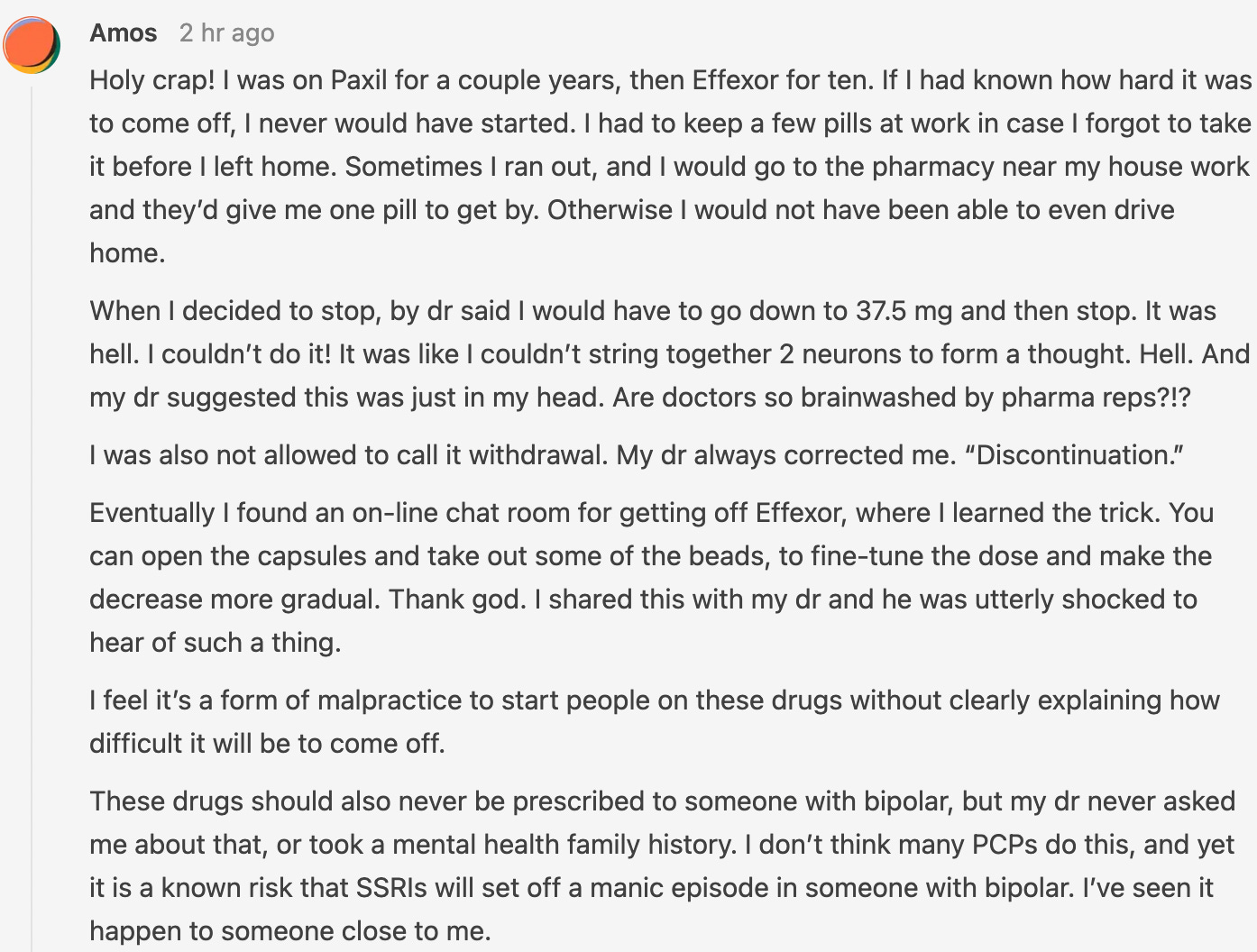
Note: I have received many similar comments from readers.
One of my relatives grew up in a big city during a particularly bad crime wave. One of his most notable memories from the time was looking up and seeing a man who was screaming “the ants are trying to get me” frantically tying bedsheets together (so he could flee down the fire escape) as armed men were rushing to his location yelling “get that mother******.” My relative ran out of the area to avoid getting shot, but from the brief look he had at the fleeing man, was almost certain that man was high on cocaine. Coke (or crack) bugs, one form of Akathisia are a well-documented phenomenon (and like many of you I have seen my fair share of cases where this happened).
Akathisia, an extreme form of restlessness is defined as a psycho-motor disorder where it is extremely difficult to stay still. What this definition omits to mention is that akathisia is incredibly unpleasant to the degree that many individuals who experience it frequently commit suicide or homicide (or both). One of the earliest reports from patients with drug-induced akathisia was: “They reported increased feelings of strangeness, verbalized by statements such as ‘I don’t feel myself or ‘I’m afraid of some of the unusual impulses I have.’”
Akathisia is much more common than most people realize. To share a personal anecdote: I occasionally discuss this topic with medical students and a few medical students have confided they previously experienced akathisia after using a psychiatric medication and it was so excruciating that one told me they seriously contemplated suicide at the time.
Akathisia (and psychosis) are known side effects of cocaine, methamphetamine, SSRIs, antipsychotics, and ADHD stimulant medications. However, while the common triggers have been identified, the actual mechanism for akathisia is still poorly understood and theorized to result from alterations in the center of the brain involved in movement. These behavioral changes are so unusual and disturbing there are often simply described as the individual appearing to be possessed.
From my own exploration of this topic, I have noticed that some individuals with cocaine intoxication (I have not yet examined a patient on the other drugs experiencing akathisia) have a characteristic (often porous) perturbation in their bio-electric field, which while very complex to describe, does resemble “frantic ants running all over the body,” and in theory could explain part of the akathisia experience.
As this idea is contained within a medical model most healthcare practitioners do not ascribe to, it has been difficult for me to evaluate the validity of this hypothesis. I have met a few other colleagues who made the identical observation, so this is a periodic topic of discussion amongst us as we believe there is significant value in developing a model that can explain this puzzling condition.
To further illustrate how perplexing the behaviors observed are on SSRIs consider this correspondence from a clinical investigator to Pfizer:
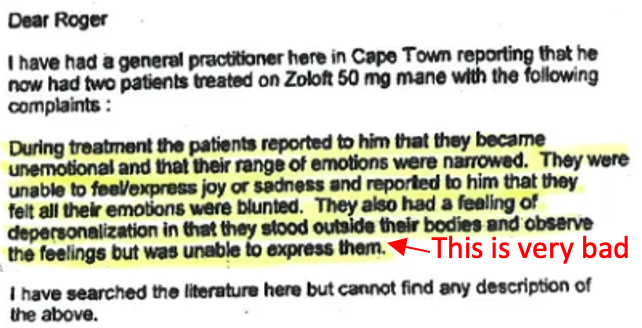
More importantly, consider Pfizer’s response:

This section will list some of the evidence substantiating the link between psychiatric medications and horrific homicides. When you review this type of information, it is very easy to intellectually disassociate from what’s contained within it. For that reason, I would like to request you first watch this two-minute video of one father who has to live with knowing he killed his child he still loves from the bottom of his heart. He was ultimately not criminally convicted, however, most individuals in these circumstances typically are.
Note: I have heard many similar stories from readers in comments here and on Twitter.
Much like the vaccine industry, the psychiatric industry will always try to absolve their dangerous medications of responsibility and will aggressively gaslight their victims. Despite these criticisms,there are three facts can be consistently found throughout the literature on akathisia homicides which Gøtzsche argues irrefutably implicate psychiatric medications as the cause of violent homicides:
• These violent events occur in people of all ages, who by all objective and subjective measures were completely normal before the act and where no precipitating factors besides the psychiatric medication could be identified.
• The events were preceded by clear symptoms of akathisia.
• The violent offenders returned to their normal personality when they came off the antidepressant.
Numerous cases where this has happened are summarized within this article from the Palm Beach Post. In most of those cases, a common trend of these spontaneous acts of violence emerges: the act of violence was immediately preceded by a significant change in the psychiatric medications used by the individual. In one case, shortly before committing one of these murders, one of the perpetrators also wrote on a blog that, while taking Prozac, he felt as if he was observing himself “from above.”
Individuals with a mutation in the gene that metabolizes psychiatric drugs are much more vulnerable to developing excessive levels of these drugs and triggering severe symptoms such as akathisia and psychosis. There is a good case to be made that individuals with this gene are responsible for many of the horrific acts of iatrogenic (medically induced) violence that occur, however to my knowledge, this is never considered when psychiatric medications are prescribed. Gøtzsche summarized a peer-reviewed forensic investigation of 10 cases where this happened (all but one of these involved an SSRI or an SNRI):
Male, 18 years, Prozac, sister was comatose after a car crash, violent akathisia for 14 days, killed his father four days after he ran out of pills.
Male, 35 years, Paxil, distressed by “on and off” relationship with mother of his child, stabbed former partner 30+ times to death after 11 weeks of akathisia.
Male, 46 years, Paxil, anxiety about not making enough money to support the family, killed his son in a manic-shift akathisia and delirium after 42 days.
Male, 16 years, Zoloft and Prozac, depressed, struggled at school, and the girlfriend left him, attempted suicide on both drugs, killed therapist in hospital after 11 weeks.
Male, 50 years, Effexor, distress over divorce, shot a stranger four days after stopping drug.
Female, 35 years, nortriptyline, distress due to husband’s drinking, killed teenage daughter in toxic delirium after three days.Male, 24 years, Lexapro, anxiety and illicit substance use, several suicide attempts and assaults, nearly killed partner, 12 years in jail for attempted murder.
Female, 26 years, several SSRIs, difficulties with in-laws, two attempts to kill her two children.
Female, 52 years, Paxil and Celexa, harassment at work, suicide attempt and tried to kill her two children.
Female, 25 years, Celexa and Effexor, marital distress, several suicide attempts on both drugs, jumped in front of a train with her child while on citalopram.
There are many other sad cases of akathisia homicides. One detailed by Gøtzsche is representative of the pharmaceutical injuries gaslighted psychiatric patients often experience. When reviewing the story, keep in mind that the FDA insert explicitly lists the following as side effects of Effexor (an SNRI): intentional injury, malaise, suicide attempt, depersonalization, abnormal thinking, akathisia, apathy, ataxia, CNS stimulation, emotional lability, hostility, manic reaction, psychosis, suicidal ideation, abnormal behavior, adjustment disorder (which became a psychiatric diagnosis for her, although it was a side effect), akinesia, increased energy, homicidal ideation, and impulse control difficulties.
A 26-year-old woman tried to kill her two children on two occasions. She was prescribed Paxil for stress but experienced an episode of rage and attempted suicide by inhalation of carbon monoxide, and then stopped taking the drug. Despite this, she was prescribed Paxil again and reassured about its safety two years later. This time she experienced intense restlessness, surges of rage and anger, panic attacks, impulsive spending sprees, and constant suicidal ideation. She reasoned that her low self-esteem, insomnia, and suicidal behavior were due to difficulties with her in-laws. She overdosed and was admitted to the hospital where her Paxil was increased. She tried to kill herself again and was diagnosed with an “adjustment disorder.”
She was switched to Effexor, which was increased over three months until the dose was eight times higher than the initial dose. Each dose increase occasioned a week spent in bed with exhaustion, as she was unable to get up (akinesia). Her mental state deteriorated and violent outbursts and suicidal ideation became frequent and severe. Unable to stay in one place, she drove several hundred miles with her children and tried to kill them and herself by car exhaust. A few days later she tried to kill her children and herself again.
Violent psychotic reactions from SSRIs can manifest as both suicides and homicides. There is extensive documentation to support the occurrence of SSRI suicides, and while the psychiatric profession still uses an endless litany of excuses to deny this happens, many antidepressants now have a black box warning from the FDA for the occurrence of suicide. The side effects were definitively known to result from SSRIs as far back as their early clinical trials (which were of course hidden from everyone) and a mountain of evidence proving this regularly occurs has accumulated since these drugs entered the market.
There are a large number of studies showing the link between SSRIs and suicide (especially those kept secret by the pharmaceutical industry). These will not be discussed as they are not the main focus of this article, but to provide some context on the issue, I will briefly discuss a microscopic and macroscopic study examining this picture. First to quote this peer-reviewed case series’s abstract:
“Six depressed patients free of recent serious suicidal ideation developed intense, violent suicidal preoccupation after 2-7 weeks of fluoxetine treatment. This state persisted for as little as 3 days to as long as 3 months after discontinuation of fluoxetine. None of these patients had ever experienced a similar state during treatment with any other psychotropic drug.”
Second, the CDC has a system for reporting violent deaths that have occurred, and one subset of those deaths are suicides (which may be associated with a homicide or a concurrent suicide). 3616 of these deaths were evaluated for the presence of an antidepressant, and 35.3% tested positive for one at the time of their death. A large number of individual mood-altering substances were tested for, and the only one that had a higher positive test rate than the antidepressants was alcohol (38.2%), although only 26.9% of those tested had enough alcohol present to be considered legally drunk. In the general population, between 11-13.2% of adults use antidepressants, which suggests there is a note-worthy correlation here.
Most of the placebo-controlled data which is available showing the instances of homicidal behavior after taking an SSRI is available because of court orders from lawsuits where someone sued an SSRI manufacturer for their actions while on the SSRI. Consider for example this report from one clinical trial:

[Pt. began to verbalize feelings of killing other people and then himself. Pt. ..…. much more anxious and depressed than baseline; even though this is not reflected in ….. —I could not make out the … parts.]
When you consider these figures, it is important to remember that while a 0.1% death rate for a drug is tragic (but typically deemed acceptable within medicine), it is incomparable in consequence to a 0.1% homicide rate for a drug.
As millions of children are given SSRIs, even numbers that small mean homicides will regularly occur. I can’t even guess how low a risk would constitute an acceptable threshold, but for the sake of conveying other points in this section, I will describe it as 0.1%. In reality, any elevated risk in this regard should be viewed as unacceptable without any exceptions. I am emphasizing this point because I have never seen it considered by proponents of psychotropic drugs.
An excellent paper reviews private pharmaceutical research made public through litigation. The paper discusses internal company documents that compared 9219 research subjects (many of whom had pre-existing psychiatric diagnoses) that received Paxil, to 6455 research subjects (also with pre-existing psychiatric conditions) that received a placebo, 0.65% of the patients in clinical trials became hostile on Paxil compared with 0.31% on placebo. The highest risk for hostility on Paxil was for those who also had Obsessive Compulsive Disorder. (0.34% is more than the 0.1% threshold)
The authors of this paper hypothesized that the violent actions following the usage of SSRIs may be explained by their tendency to trigger akathisia, emotional blunting, and manic or psychotic reactions. I will quote a few select passages from that paper:
In healthy volunteer studies, hostile events occurred in three of 271 (1.1%) volunteers taking Paxil, compared with zero in 138 taking placebo.” (1.1% is more than 0.1%).
In data from sertraline pediatric trials submitted by Pfizer, aggression was the most common cause for discontinuation [removal from the trial] from the two Zoloft placebo-controlled trials in depressed children. In these trials, eight of 189 patients randomized to Zoloft were discontinued for aggression, agitation, or hyperkinesis (another term for akathisia frequently used to conceal it), compared with discontinuations for these reasons in the 184 patients on placebo…When discontinuations for any manifestation of treatment induced activation (suicidal ideation or attempts, aggression, agitation, hyperkinesis, or aggravated depression) were considered, there were 15 discontinuations on Zoloft compared with two on placebo, which meant this was 7.3 times more likely to happen when on sertraline.” (8.9% is more that 0.1%., 7.3 times more likely likewise is also unacceptable).
In pediatric trials of Effexor, two percent of children dropped out because of hostility, more than double the rate of dropout on placebo.After a program on Paxil in 2002, the producers of the BBC television programme Panorama received 1,374 e-mails from viewers, mostly patients. Researchers then analyzed the full set of these responses. Many respondents linked emotional storms and thoughts and acts of violence or self-harm to Paxil, both to starting drug treatment and to dosage change.
These were not simple anecdotal reports, in that the analysis clearly pointed to a linkage with dosage. Second, they were self-reports of violence from patients with no apparent background of violent behavior. Third, the analysis was consistent with an analysis of reports of thoughts and acts of violence or self-harm on paroxetine that doctors had sent to the MHRA (England’s FDA) about other patients between 1991 and 2002.
In both patient and medical reports, severe mood changes were commonly associated with changes of drug dosage during the first week of treatment, with later dosage increase, or with dosage decrease or drug withdrawal. The accounts reported in both the medical and the patient series had much in common, including time frame and a linkage to dosage.
Gøtzsche likewise has located less biased sources of data on the violent risks of SSRIs:
As the published trial literature related to suicidality and aggression on antidepressants is unreliable, we looked at 64,381 pages of clinical study reports (70 trials) we got from the European Medicines Agency. We showed for the first time that SSRIs in comparison with placebo increase aggression in children and adolescents, odds ratio 2.79 (95% CI 1.62 to 4.81) (2). This is an important finding considering the many school shootings where the killers were on SSRIs.
In a systematic review of placebo-controlled trials in adult healthy volunteers, we showed that antidepressants double the occurrence of events that the FDA has defined as possible precursors to suicide and violence, odds ratio 1.85 (95% CI 1.11 to 3.08)(3). The number needed to treat to harm one healthy adult person was only 16 (95% CI 8 to 100).
Based on the clinical study reports, we showed that adverse effects that increase the risk of suicide and violence were 4-5 times more common with duloxetine than with placebo in trials in middle-aged women with stress urinary incontinence. There were also more women on duloxetine who experienced a core or potential psychotic event, relative risk RR 2.25 (95% CI 1.06 to 4.81). The number needed to harm was only seven. It would have been quite impossible to demonstrate how dangerous duloxetine is, if we had only had access to published research. In accordance with our findings, the FDA has previously announced that women who were treated with duloxetine for incontinence in the open-label extension phase of the clinical studies had 2.6 times more suicide attempts than other women of the same age.
Gøtzsche has also reviewed some of the key legal cases regarding SSRIs:
Akathisia homicides have been defended as instances of involuntary intoxication both with and without genetic evidence, and some people have succeeded in receiving damages from the manufacturers for failure to warn…the filings in a case on Paxil against SmithKline Beecham [now named GSK] included an unpublished company study of incidents of serious aggression in 80 patients, of which 25 resulted in homicide. In one case, a man aged 74 strangled his wife, and another was 66 when he became delusional on Prozac and killed his wife who was found with 200 stab wounds.
In 2001, for the first time, a jury found a pharmaceutical firm liable for deaths caused by an antidepressant. Donald Schell, aged 60, had been taking Paxil for just 48 hours when he shot and killed his wife, his daughter, his granddaughter and himself.
Central to the case were SmithKline Beecham internal documents showing the company was aware that a small number of people could become agitated or violent from Paxil. Despite this knowledge, paroxetine packaging deliberately did not include a warning about suicide, violence or aggression.
The internal documents, stamped “confidential,” list the results of tests involving more than 2,000 healthy volunteers taking either Paxil or placebo. Some volunteers experienced anxiety, nightmares, hallucinations and other side effects – definitely caused by the drug – within two days of taking it. Two volunteers attempted suicide after 11 and 18 days, respectively…Ten years after the verdict, GSK still denies that Paxil can cause people to commit homicide and suicide and that there are withdrawal problems.
Typically, American courts are more likely to rule in favor of the pharmaceutical company, and Donald Shell was a lucky exception. For example consider the three following cases:
Christopher Pittman became manic and shot his two grandparents to death two days after his dose of Zoloft had been doubled. Despite being only 12 years old when he did this, he was sentenced to 30 years of prison.
David Crespi was on Prozac and three other drugs, which he had taken for a couple of weeks, when he killed his two twin daughters with a knife. He pleaded guilty to avoid the death penalty and got a life sentence with no chance of parole, although he became his old self after coming off the drugs.Kurt Danysh was 18 years old when he was inappropriately prescribed Prozac by a general practitioner . He became restless and violent and shot his father, the person he loved the most, 17 days later in a totally out-of-character mood. Kurt had no history of violence prior to Prozac, but in 1996, he was convicted of murdering his father and sentenced to 22.5 to 60 years in prison. During this case, Eli Lilly lied in court, and claimed that Prozac would not cause aggressive behaviour resulting in his conviction. Later in 2004 when it was exposed Lilly had concealed data from 1988 showing Prozac caused violence, the FDA recognized that SSRIs can cause violent behaviour, particularly in children and adolescents. Despite these events and dozens of cases of homicide linked to Prozac that had subsequently been reported to the FDA, the judge has dismissed all appeals, and it took 24 years of legal work and petitioning for Kurt to finally be released from prison.


Note: Pfizer’s manual that was used to criminally convict victims of its SSRI so the market for it could be protected from public scrutiny can be viewed here. Having reviewed it, I can state with certainty Pfizer included statements known to Pfizer to be false at the time this was written. If you have time after you finish reading this article, I would highly recommend reading Pfizer’s prosecutor manual so you can see just what vintage early 1990s gaslighting looked like (it is quite a bit more sophisticated now).
Additionally, the judgement from Witczak’s lawsuit against Pfizer can be viewed here and many more appalling stories from whistleblowers within Pfizer can be viewed here and here.
Gøtzsche also notes the Canadian court system is more considerate of pharmaceutical homicide. For example:
In 2011 a Canadian judge ruled that Prozac induced a 16-year old boy to commit murder; he knifed a friend to death. In another case David Carmichael, who killed his 11-year old son while on antidepressants, was ruled “not criminally responsible on account of a mental disorder,” and today, Carmichael writes and speaks on the dangers of antidepressants.
Because many of the difficult to believe topics I cover on this substack are much more common than most realize, I periodically have readers with direct experience of the events highlighted within the articles here. This comment from a reader after the article was published highlights why I have repeatedly emphasized the importance of not abruptly discontinuing an SSRI:
In the early 90’s (can’t remember the exact year) I personally knew and was involved with the family of the 66 year old man you mentioned that stabbed his wife over 200 times then killed himself. We were all members of a small community church and we used to go to their house for Bible study. His children sued Eli Lilly (not for the money , they became quite wealthy) but to have Prozac labeled with all these warnings .The saddest thing was that if they knew there was any chance this could happen when he stopped the drug, they would have hired round the clock in home care to be sure he was doing ok. They had the means to do whatever it would have taken to be safe during that time but they just didn’t have the knowledge . It was the saddest time that will always be with me.
Note: I also have met people directly affected by SSRI violence.
In the 1990s, school shootings transitioned from being very rare to a frequent facet of American life. As this timeline overlaps with the entrance of SSRIs to the US market, many articles have evaluated the link between mass shootings and psychiatric medications. I will quote a one of the more comprehensive summaries (written in 2013) which attempted to analyze all known mass shootings:
•Eric Harris age 17 (first on Zoloft then Luvox) and Dylan Klebold aged 18 (Columbine school shooting in Littleton, Colorado), killed 12 students and one teacher and wounded 23 others, before killing themselves. Klebold’s medical records have never been made available to the public.
•Jeff Weise, age 16, had been prescribed 60 mg/day of Prozac (three times the average starting dose for adults!) when he shot his grandfather, his grandfather’s girlfriend and many fellow students at Red Lake, Minnesota. He then shot himself. Ten dead, 12 wounded.
•Cory Baadsgaard, age 16, Wahluke (Washington state) High School, was on Paxil (which caused him to have hallucinations) when he took a rifle to his high school and held 23 classmates hostage. He has no memory of the event.
•Christopher Pittman, age 12, murdered both his grandparents while taking Zoloft.
•Kip Kinkel, age 15, (on Prozac and Ritalin) shot his parents while they slept then went to school and opened fire, killing two classmates and injuring 22 shortly after beginning Prozac treatment.
•Luke Woodham, age 16 (Prozac) killed his mother and then killed two students, wounding six others.
•A boy in Pocatello, ID (Zoloft) in 1998 had a Zoloft-induced seizure that caused an armed standoff at his school.
•Michael Carneal (Ritalin), age 14, opened fire on students at a high school prayer meeting in West Paducah, Kentucky. Three teenagers were killed, five others were wounded.
•Andrew Golden, age 11, (Ritalin) and Mitchell Johnson, aged 14, (Ritalin) shot 15 people, killing four students, one teacher, and wounding ten others.
•TJ Solomon, age 15, (Ritalin) high school student in Conyers, Georgia opened fire on and wounded six of his classmates.
•James Wilson, age 19, (various psychiatric drugs) from Breenwood, South Carolina, took a .22 caliber revolver into an elementary school killing two young girls and wounding seven other children and two teachers.
•Elizabeth Bush, age 13, (Paxil) was responsible for a school shooting in Pennsylvania
•Jason Hoffman (Effexor and Celexa) – school shooting in El Cajon, California
•Neal Furrow (Prozac) in LA Jewish school shooting reported having been court-ordered to be on Prozac along with several other medications.
•Hammad Memon, age 15, shot and killed a fellow middle school student. He had been diagnosed with ADHD and depression and was taking Zoloft and “other drugs for his conditions.”
•Matti Saari, a 22-year-old culinary student, shot and killed nine students and a teacher, and wounded another student, before killing himself. Saari was taking an SSRI and a benzodiazapine.
•Steven Kazmierczak, age 27, shot and killed five people and wounded 21 others before killing himself in a Northern Illinois University auditorium. According to his girlfriend, he had recently been taking Prozac, Xanax, and Ambien. Toxicology results showed that he still had trace amounts of Xanax in his system.
•Finnish gunman Pekka-Eric Auvinen, age 18, had been taking antidepressants before he killed eight people and wounded a dozen more at Jokela High School – then he committed suicide.
•Asa Coon from Cleveland, age 14, shot and wounded four before taking his own life. Court records show Coon was on Trazodone.
•Jon Romano, age 16, on medication for depression, fired a shotgun at a teacher in his New York high school.
The article also discussed a few recent school shootings where the information to determine if a psychiatric medication was used was not available:
•What drugs was Jared Lee Loughner on, age 21…… killed six people and injuring 14 others in Tuscon, Az? [I was unable to locate any information on this case]
•What drugs was James Eagan Holmes on, age 24….. killed 12 people and injuring 59 others in Aurora Colorado? [Holmes was on Zoloft, which likely triggered violent behaviors in him in the weeks preceding the mass shooting, all of which his psychiatrist ignored.]
•What drugs was Adam Peter Lanza on, age 20, Killed 26 and wounded 2 in Newtown Ct.? [Lanza was later confirmed to have been prescribed Celexa in the past and was on a questionable antipsychotic, fanapt, known for inducing violent behavior at the time of the shooting].
Since the time that article was published, there have been five additional large school shootings:
•Christopher Harper-Mercer (2015) who killed 10 was likely on psychiatric medication but there is no definitive proof.
•Nikolas Cruz (2017) who killed 17 was likely on psychiatric medication but there is no definitive proof.
•Dimitrios Pagourtzis (2018) who killed 10 was probably not on a psychiatric medication. His attorney said he was not (which may have been a deceitful legal maneuver, but most likely was the truth), while the president of the NRA said he was (and I was not able to determine his basis for this assertion).
•For Salvador Ramos (2022) who recently killed 22, there have been many posts stating he was on antidepressants, but while there is some circumstantial evidence suggesting this, there is presently no reliable information to confirm or deny it. For a more detailed summary of my thoughts on this matter, please see this comment.
•With the recent school shooter Audrey Hale, most of the focus has been on the shooter presumably taking testosterone, as this can trigger aggression. While like many things, this potentially explains what happened, in the reports I found where testosterone led to homicidal behavior, it required a pre-existing psychiatric illness (which would typically be treated with a violence inducing psychiatric medication) to also be present. Since a clear link has already been established to psychiatric medications causing this behavior (and based on the shooter’s background it is likely some were prescribed), I would suggest that until more information becomes known, the standard psychiatric medication violence it is a more probable explanation for the recent tragic events.
While the tendency to provoke violence toward others is a major issue with SSRIs and other related medications, it is rarely considered a side effect of these drugs. One reason for this is that the other severe adverse effects from these medications are much more common (for example, SSRIs are the most common cause of bipolar I) and as a result, these awful effects occupy a disproportionate focus when discussing their toxicity. I however focused on this issue, because like the sudden deaths caused by the COVID-19 vaccines, it is so unmistakable and concerning it cuts through any the ambiguity over what the drug/vaccine is doing.
Sadly, In addition to SSRIs extremely damaging, it is very questionable if for most people these drugs have any benefit beyond statistical artifacts created by biased corporate research studies (note: there are a variety of metabolic causes of depression, one of which responds to SSRIs and I believe this subset accounts for the significant benefit a minority of users experience from SSRIs even though more benefit is obtained from treating the metabolic cause).
To illustrate how illusory the benefits are: John Virapen, the pharmaceutical executive largely responsible for bringing these drugs to market, later revealed that after exploring if Prozac could be used to treat depression, Eli-Lilly discovered it had a much more lucrative side effect—it caused patients to lose weight. Unfortunately, since this concrete metric would be much more difficult to prove, Lilly decided to pursue approving the drug based on a subjective metric that would be easier to fabricate the data to substantiate, and then pivot to using it for obesity once it was approved (this is a common industry tactic). Sadly, as Virapen detailed in his memoir, before its approval, the evidence showing Prozac worked for depression was atrocious while abundant evidence existed for its harm.
This then raises the question: how could these drugs have possibly been approved and kept on the market?
In the previous series on the (proven) corruption in the COVID-19 response, I tried to illustrate that the conduct of the federal government was beyond egregious and that they were following a very similar corrupt playbook that existed long before COVID-19. Both the vaccines and Prozac (and their subsequent iterations) should have never been approved, but they were approved due to an incestuous and meticulously woven web of corruption that went to the very top of the federal government.
The number one goal of the pharmaceutical business is to produce markets for expensive drugs which will be indefinitely taken by the majority of the population. Psychiatric medications and the COVID-19 vaccinations represent two of the most lucrative fulfillments of these business objectives. I believe that the extreme potential profit they hold incentivized and enabled their pharmaceutical manufacturers to remove all regulatory obstacles to these drugs entering widespread adoption.
The major difference now is that the COVID vaccinations have complete legal immunity. On one hand, this means the manufacturers have no concern for the potential toxicity of their medications. More importantly, however, this means it will never be possible to force the manufacturers to disclose their privately conducted studies showing the actual harms of the medications. We cannot rely on the federal government to do so either, because the entire HHS has been complicit in gaslighting the entire population.
The primary reason we know most of the harms associated with SSRIs is because they were toxic enough to severely harm a large number of people who subsequently were sufficiently motivated to fight the drug companies in court (very few drugs have caused enough damage to mobilize this type of response). If it were possible to sue Pfizer, Moderna, or J&J directly, most of that information would already be public knowledge. Rather, we can only sue the federal government, which is a protracted process, where at best, we can only get breadcrumbs of the truth.
One of the reasons I was able to accurately predict and understand all of the shenanigans that would be done to force the COVID vaccine through was because I was intimately familiar with what happened with the SSRIs. With these drugs, because of a courageous whistleblower (John Virapen) and documents released in court, it is possible to gain an intimate understanding of how these companies operate and the specific forms of fraud they commit.
Put differently, extensive bribery, deliberate falsification of clinical trial data, the highest leaders within the government being quarterbacks for these drugs, and the FDA doing everything it could to conceal adverse events has been proven to have occurred for the SSRIs and are discussed in part 2 of this series:
The Forgotten Side of Medicine
How the FDA Buried the Dangers of Anti-Depressants
I believe what happened with the SSRIs is critical to review because the historical record of the FDA’s malfeasance with these drugs is the closest parallel we have to what happened with the COVID vaccines. Both were pushed onto the market and then protected continually despite a deluge of evidence starting the second they entered the market which showed they needed to be pulled from the market immediately. Observing how this was handled over decades provides a valuable guide for predicting how the vaccine disaster will be handled in the years to come and how to prevent them from being shielded like the SSRIs were.

Finally, the time this article was published, leaders in the conservative media have begun to discuss the subject of the connection between SSRIs and Mass shootings. This is very encouraging and it is my hope we may, at last, be starting to move toward addressing this issue.
One of the most common arguments used to dismiss the link between psychiatric medication and violent behavior is the notion that the people who have mental illness are the ones who receive those medications, so the correlation observed may be due to the pre-existing mental illness rather than the medication. As this article has shown, many people (and quite a few readers) who were completely normal prior to the SSRI developed those tendencies after they started the medication.
However, there is also a more important piece of evidence. SSRI caused violence was repeatedly detected in the clinical trials for these drugs, but covered up by both the pharmaceutical industry and the FDA. It only became known because lawsuits forced the manufactures to reveal it. These points are further discussed in the second part of the series linked to above.
As we conclude, I recognize that this is an immensely challenging subject and I appreciate you for being able to maintain a level head while reading it. Thank you for the time and focus you have given to this topic and for sharing it with others who can benefit from it. Lastly, I know this is already been stated, but do not attempt to stop taking an SSRI without the assistance of a physician who understands how to taper them. Very bad things can happen if you do not follow that advice.
…………………..
John Mortimer’s fictional barrister was—like his creator—a rogue redeemed by a fierce commitment to the presumption of innocence.

· 18 min read
The Trials of Rumpole – Read by Leo McKern (2:21:53 min) Audio Mp3
Rumpole of the Bailey – Read by Leo McKern – Abridged (2:42:36 min) Audio Mp3
I.
Horace Rumpole deserves a place alongside Bertie Wooster, Sherlock Holmes, Hercule Poirot, James Bond, and Father Brown as one of the best creations in all of British popular fiction. The fact that he began his career as a made-for-TV character rather than in the pages of a book, or even a magazine, seems to have worked against him. The brainchild of barrister-turned-writer John Mortimer, Rumpole first appeared on television on December 17th, 1975, in a BBC anthology series called Play for Today.
Mortimer was born 100 years ago this month, and when Rumpole first appeared, he had already been earning a living as a writer since the 1940s. He graduated with a law degree from Oxford in 1943, but then immediately went to work writing documentary films for Britain’s Ministry of Information. His first novel, Charade (1947), was based on that experience. The following year, aged 25, he was called to the bar. For the next 35 years or so, he pursued dual careers, as a barrister specializing in the defense of free speech and criminal defendants, and as a writer of stage plays, radio plays, teleplays, essays, memoirs, and novels. After retiring from the bar in 1984, Mortimer continued to put out a book or two a year—most but by no means all of which featured Horace Rumpole—until his death at 85 in 2009.
Some of his early radio and TV plays featured characters that can be viewed as precursors to Horace Rumpole; put-upon barristers struggling for a foothold in the legal profession and largely failing. But it wasn’t until 1975 that he finally came up with the character whom, at first, he called Horace Rumbold (the name was changed when it turned out that a real-life barrister already bore that name). That teleplay was called Rumpole of the Bailey, a reference to the Old Bailey, which is the Central Criminal Court of England and Wales, where Rumpole plied his trade as a defense attorney.
It was a hit with critics, and the producer of the teleplay, Irene Shubik, hoped to turn it into a regular series. The BBC wasn’t interested, so Shubik took the project to Thames Television. The series debuted on April 3rd, 1978, and ran for six episodes. An additional six seasons would follow between 1979 and 1992. Fans of the series will know that Rumpole was brilliantly played by Leo McKern, an Australian actor, and that his wife, Hilda (“She Who Must Be Obeyed”), was played by Peggy Thorpe-Bates for the first three seasons and by Marion Mathie for the final four.
(cont. https://archive.ph/fPaW6 )
……………………
By Tom Weber
……………….
What took place on one single day near a small village west of Moscow turned out to be the beginning of the end for Napoleon Bonaparte, the great military strategist from Corsica who rose quickly through the ranks to become France’s youngest general and eventually its first emperor.

Through a combination of modern-day technology and a painter’s artistic touch, this photojournalist, invited by Insight Vacations to document its Easy Pace Russia journey, is transported back in time to September 7, 1812 as French and Russian forces collide on a massive amphiteatre-like clearing near tiny Borodino.

I’m standing on a circular platform at the top of the Battle of Borodino Panorama Museum in Moscow looking down and panning right and left, taking in every detail of a gigantic 360-degree oil painting created by Franz Roubaud, a panoramic master, in 1911.
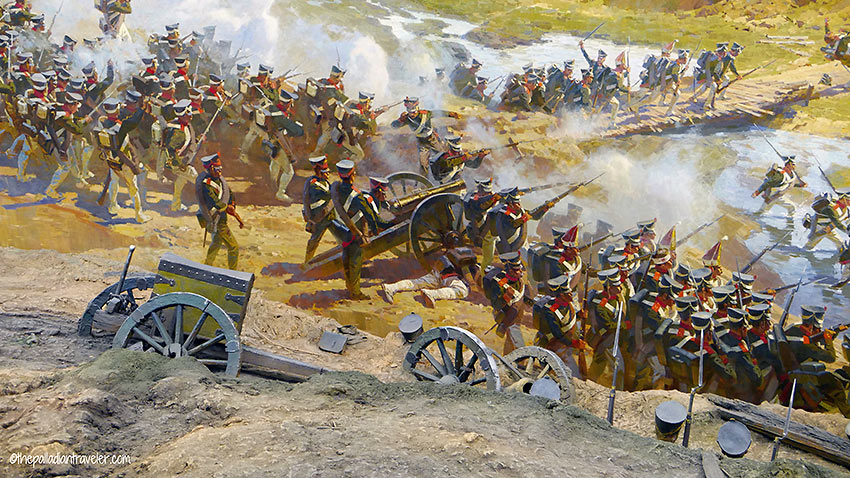
This tableau of bloodshed, standing 15m tall and stretching 115m around, is impressive. Along with Roubaud’s brush strokes, the added dimension and depth of dramatic set recreations in the foreground, special lighting and realistic sound effects make me feel as if I’m actually there, standing alongside Pierre, Leo Tolstoy’s naive, unworldly hero from War and Peace, witnessing the bloodiest battle of the Napoleonic Wars.

Nearly 250,000 French and Russian forces answered the call that sunny, September day, but when the last cannon sounded and the final saber rattled, nearly 75,000 brave souls had perished on the battlefield.

Napoleon himself summed up the battle best: “The most terrible of all my battles was the one before Moscow. The French showed themselves to be worthy of victory, but the Russians showed themselves worthy of being invincible”.

What was left of the Imperial Army of Russia retreated, burning every hamlet, village and town in its wake, while Napolean’s equally depleted, but tactically victorious, Grande Armée continued its march to Moscow, some 115 km (70 mi) away, only to find it, too, deserted and ablaze.
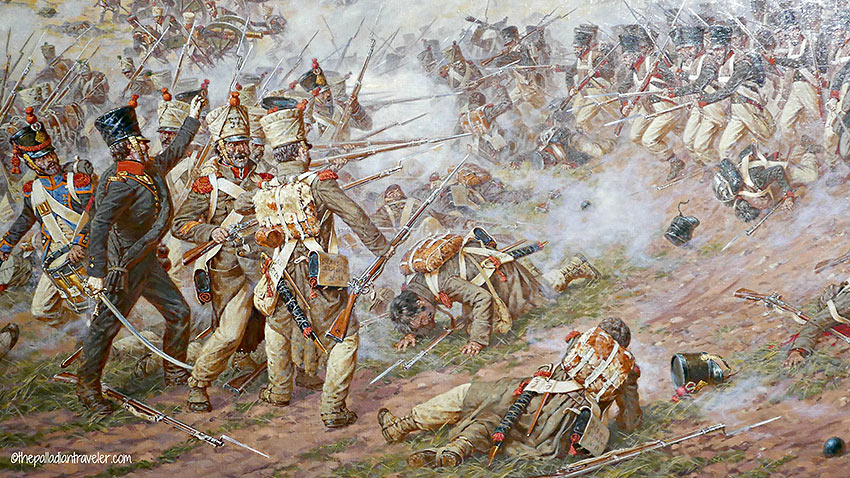
Holed up inside the Kremlin for five long weeks, Napoleon waited impatiently for an official surrender from Alexander I, Emperor of Russia, but it would never come. Totally frustrated and weary, Napoleon limped back to Paris, in the middle of a harsh Russian winter, leaving behind nearly three-quarters of his original 600,000-manned invasion force dead, strewn about the countryside.

Celebrated historian Oleg Sokolov observed that the significance of the battle came much, much later. “The importance of Borodino,” he noted, “is by literature, by history, by poetry. It’s not so important strategically.”

Mikhail Lermontov wrote a poem, Borodino, that’s read and recited by every Russian schoolchild. Tolstoy made the battle the focal point in his aforementioned epic novel. And, 19th century symphonist Pyotr Ilyich Tchaikovsky composed the world-renowned and easily-recognizable 1812 Overture, complete with cannon fire, that today accompanies elaborate, choreographed pyrotechnics that light up the sky above the annual Fourth of July concert on the Mall in Washington, DC.

The Battle of Borodino, the event that signaled the beginning of the end for Napoleon and, to a lesser degree, the conclusion of my visit to the Panorama Museum, the very last stop on this week-long, Easy Pace Russia journey. I just wish it were the overture and not the finale.
………………………
Do svidaniya!
…………………………..